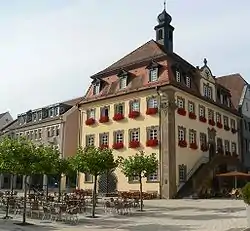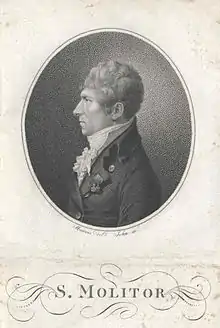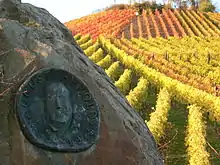Neckarsulm
Neckarsulm (German pronunciation: [nɛkaʁˈzʊlm]) is a city in northern Baden-Württemberg, Germany, near Stuttgart, and part of the district of Heilbronn. As of 2016, Neckarsulm had 26,800 inhabitants.[2] The name Neckarsulm derives from the city's location where the Neckar and Sulm rivers meet.
Neckarsulm | |
|---|---|
 | |
 Coat of arms | |
Location of Neckarsulm within Heilbronn district  | |
 Neckarsulm  Neckarsulm | |
| Coordinates: 49°11′30.1″N 9°13′28.4″E | |
| Country | Germany |
| State | Baden-Württemberg |
| Admin. region | Stuttgart |
| District | Heilbronn |
| Subdivisions | 4 |
| Government | |
| • Mayor | Steffen Hertwig (2016) |
| Area | |
| • Total | 24.94 km2 (9.63 sq mi) |
| Elevation | 162 m (531 ft) |
| Population (2019-12-31)[1] | |
| • Total | 26,528 |
| • Density | 1,100/km2 (2,800/sq mi) |
| Time zone | UTC+01:00 (CET) |
| • Summer (DST) | UTC+02:00 (CEST) |
| Postal codes | 74172 |
| Dialling codes | 07132 |
| Vehicle registration | HN |
| Website | Neckarsulm.de |
Neckarsulm is known for its renewable energy projects and wine. The Weingärtnergenossenschaft Neckarsulm-Gundelsheim, or Neckarsulm-Gundelsheim winegrower's cooperative, is the oldest winegrower's collective in Germany. Trollinger and lemberger are the principal varieties of grape grown in this region. Schwartz Gruppe (Schwartz Group), which operates the grocery stores Lidl and Kaufland, is headquartered in Neckarsulm.
Neckarsulm was first mentioned in a document in 771 and received town charter around 1300.[3] The city celebrates its 1250th birthday in 2021.[4]
History and Geography
Neckarsulm is located in the Neckar River Valley. The town is approximately 30 kilometers (18.6 miles) from the Löwenstein Mountains, part of the Swabian-Franconian Forest. The closest city is Heilbronn, the sixth largest city in Baden-Württemberg.
The urban area of Neckarsulm consists of the core city and the districts of Amorback, Dahenfeld, and Obereisesheim.
Archeological evidence indicates human activity in the greater Neckarsulm region as early as the 6th millennium. Graves found South of the old city walls indicate a Franconian settlement dating to the 7th century AD. [5]
Previously known as "Sulmana" or "Sulmgau," the city dates its founding to 771, as documented in a deed of donation to the Lorsch Abbey. References to Sulmana appear in the Lorsch Codex.[6] The area became known as Neckarsulm during the 16th century.[7]
Notable Landmarks
- German Two-Wheeler and NSU Museum - a museum dedicated to two-wheeled vehicles including riding cars and motorcycles produced in Germany. The museum is housed in the Teutonic Order Castle Neckarsulm.
- Stadtmuseum Neckarsulm - City museum of Neckarsulm that tells the history of the city from mideval times to present day. The building housing the museum dates to 1545. [8]
- Neckarsulm TDS Office Tower
- Obereisesheim transmitter
- Remnants of the medieval city wall along the rives.
Mayors and Lord Mayors
- 1845–1865: Franz Josef Alexander Heinrich Becker
- 1865–1878: Josef Pecoroni
- 1878–1885: Johann Nepomuk Kirner
- 1885–1911: Bernhard Rettenmeier
- 1911–1913: Heinrich Soller
- 1913–1941: Johannes Häußler
- 1942–1945: Oskar Volk
- 1945–1946: Hermann Greiner
- 1946–1949: Johannes Häußler (1879–1949)
- 1949–1955: Erwin Wörner
- 1955–1967: Hans Hoffmann (1915–2005)
- 1967–1992: Erhard Klotz (born 1938)
- 1992–2008: Volker Blust
- 2008–2016: Joachim Scholz [9]
- since 2016: Steffen Hertwig
Population
The numbers are estimates, census results (¹) or data from statistical offices.
|
|
|
¹ Census results
² The population increase between 1950 and 1961 comes from the new district Neckarsulm-Amorbach. In 1955, around 3,000 people lived in this place.[10]
Economy
Schwarz Gruppe, owner of Lidl and Kaufland — the largest European grocery chain — has its head office in Neckarsulm.[11]
The city was the home of the car manufacturer NSU which was taken over by Volkswagen in 1969 and merged with Auto Union to create Audi. The former NSU factory is now one of Audi's two principal assembly plants in Germany and manufactures the company's larger, high end models such as the Audi A6, A7, A8. Audi's performance subsidiary Audi Sport GmbH, which manufactures the R8, is also located here. The NSU logo on early vehicles stands for the city name Neckarsulm.[12]
Further notable companies, headquartered in Neckarsulm, include Fujitsu TDS, Bechtle AG and Rheinmetall Automotive AG.[13]
Notable people
Honorary citizens of Neckarsulm
- 1894: Franz Joseph Maucher (1826–1910) was a chaplain and parish priest in Neckarsulm for 35 years.
- 1911: Gottlob Banzhaf (1858–1930) was Kommerzienrat and after the death of his brother Christian Schmidt first director the Neckarsulmer Strickmaschinenfabrik AG from 1884 to 1910.
- 1930: Ernst Josef Bauer (1881 † in Ludwigsburg) was a teacher and successful author of the local play "Peter Heinrich Merkle, the Löwenwirt of Neckarsulm".
- 1933: Christian Mergenthaler (1884–1980), NSDAP politician, Prime Minister of Württemberg from 1933 to 1945. On 27 July 1933, Neckarsulm granted him honorary citizenship which was revoked on 28 August 1945.[14]
- 1949: Johannes Häußler (1879–1949) was mayor of Neckarsulm for 30 years.
- 2004: Kurt Bauer (born 1934) was city council for 36 years, deputy mayor, SPD parliamentary leader and chairman of the SPD local association.
- 2008: Volker Blust (born 1944) was head of the city's main and personnel office and was elected in 1992 as mayor of Neckarsulm.
Born in Neckarsulm
- 1766, November 3, Franz Simon Molitor, † 21 February 1848 in Vienna, musician


- 1902, 7 August, August Herold, † 8 January 1973 by Neckarsulm; vine growers
Other people connected to the city
- Wilhelm Ganzhorn (born 1818 in Böblingen, † 1880 in Bad Cannstatt) was in Neckarsulm 1859–1878 senior judge. Ganzhorn was a poet, and was known as the author of the text for the song "In the loveliest meadow" (Im schönsten Wiesengrunde).

- Albert Roder (born 1896 in Nuremberg; † 1970 in Heilbronn) was an engineer, who became known for the construction of motorcycles. He was from 1946 to 1961 chief designer at NSU.
- Klaus Zwickel (born 1939 in Heilbronn), German unions functionary and former Chairman of IG Metall. From 1968 to 1983 he was first secretary of the IG-Metall Headquarter Neckarsulm.
- Verena Stenke (born 1981 in Bad Friedrichshall), German artist.
- Dominik Britsch (born 1987 in Bad Friedrichshall), German boxer
Sister Cities
| City | Country | Year |
|---|---|---|
| Carmaux | ||
| Bordighera | ||
| Grenchen | ||
| Zschopau | ||
| Budakeszi |
Gallery
 Pedestrian zone on the market place
Pedestrian zone on the market place Old House
Old House
 The Deutschordensschloss (a former castle of Teutonic Knights) houses the Deutsches Zweirad- und NSU-Museum
The Deutschordensschloss (a former castle of Teutonic Knights) houses the Deutsches Zweirad- und NSU-Museum Vineyards on Scheuerberg mountain
Vineyards on Scheuerberg mountain
References
- "Bevölkerung nach Nationalität und Geschlecht am 31. Dezember 2019". Statistisches Landesamt Baden-Württemberg (in German). September 2020.
- Neckarsulm, Stadt. "Neckarsulm - Daten & Fakten". www.neckarsulm.de (in German). Retrieved 25 July 2019.
- Content in this edit is translated from the existing German Wikipedia article at de:Neckarsulm; see its history for attribution.
- "1250 jahre neckarsulm (1250 Years of Neckarsulm)". neckarsulm.de (in German).
- Thierbach, Werner; Jacob, Christina (1992). "Vor- und Frühgeschichte im Neckarsulmer Raum". Neckarsulm. Die Geschichte einer Stadt. Stuttgart. pp. 25–30.
- "'Neckarsulm' in Lorsch Codex". ub.uni-heidelberg.de (in German).
- "1250 jahre neckarsulm (1250 years of Neckarsulm)". neckarsulm.de (in German).
- "Stadtmuseum Neckarsulm (Neckarsulm City Museum)". stadtmuseum-neckarsulm.de.
- Andreas Bracht: OB Joachim Scholz wird in sein Amt eingesetzt. Presse-Information der Stadt Neckarsulm vom 27. Oktober 2008.
- Bernd Friedel: 50 Jahre Amorbach. Neckarsulm 2005, pp. 6–16.
- "Impressum Archived 27 July 2014 at the Wayback Machine." Lidl. Retrieved on 28 September 2012. "Adresse: Lidl Stiftung & Co. KG Stiftsbergstraße 1 74167 Neckarsulm "
- "Die NSU-Firmengeschichte". Retrieved 1 January 2016.
- Wilson, Hugo (1995). "The Directory of Motorcycles". The Encyclopedia of the Motorcycle. London: Dorling Kindersley. p. 245. ISBN 0-7513-0206-6.
Around 1890 Neckarsulm Strickmaschinen – "knitting machine" – Union began making bicycles.
- Anton Heyler: Neckarsulm im Auf und Ab eines halben Jahrhunderts. (s. Literatur), pp. 58 and 92.